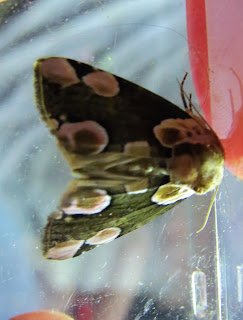 |
| Moth night at Mousehold Heath |
 |
| Rosy Footman |
There were plenty of moths to look at tonight and one of the real highlights was rosy footman. It is a rather beautiful orange-pink moth. To me, the edge of the wing looks like a highlighted pink love heart bordering a black scribbled love message in the centre.
 |
| Peach Blossom |

 |
| Maiden's Blush |
 |
| Riband Wave |
This is a riband wave and belongs to the same family group as the maiden's blush, which is the wave family. Most wave moths have this distinctive wing shape and they are usually spread open when at rest. They also have various lined patterns that differs from species to species. These patterns can be rather showy to very faint. The riband wave has two forms. The one here is one of the more common out of the two forms with three ribbon-like lines across the middle.
 |
| Mottled Beauty |
Most species of moth are considered dull, brown and can cause a lot of confusion when trying to tell them apart. Take this mottled beauty. It ticks all the boxes of being dull, brown and confusing. But take a closer look and you can see the subtle pattern of wavy lines and the two faint splodges on it's forewings. Subtle, but beautiful.
 |
| Dark Arches |
Here's another brown moth for you, a dark arches. Out of all the moths we caught tonight, it is one of the largest. The species is also quite variable. Some can be dark in colour, others more lighter, but they all have the same wing pattern. On each wing there are two kidney-shaped blotches in the centre and a little 'W' at the bottom.

 |
| True Lover's Knot |
The true lover's knot is another moth with a great name. It is a small but pretty brown moth with distinctive white and cream markings. These markings at a glance appear to twist and turn with one another as if creating a knot. This is a heathland species that thrives on heather.
 |
| Scorched Wing |
My personal favourite tonight was this scorched wing. It is a very unmistakable moth, you can not confuse it with anything else. It is yellow-brown, riddled with fine lines and appears as if someone singed parts of it's wings, hence the name.

 |
| Common Emerald |
Are we sick of brown moths yet? Well here's a green one. It's a common emerald. It is a fairly common species and can be found in gardens, parks, woodlands and heaths. It is also much smaller and brighter green compared to the light emerald, which was also caught tonight.
 |
| Light Emerald |
 |
| Buff Ermine |
Finally, here's a lovely buff ermine. It is white with a row of black lines that meets at the centre as well as two other dots at the side. What I like the most about this moth, though, is it's fluffy thorax and head.
No comments:
Post a Comment